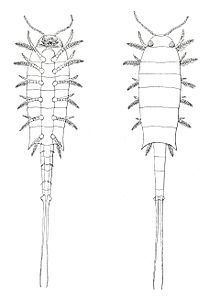Rank Subclass | ||
 | ||
Order EuthycarcinidaGall & Grauvogel, 1964 Similar Protichnites, Climactichnites, Lepidocaris, Aglaspidida, Archipolypoda | ||
Euthycarcinoidea was a enigmatic group of possibly amphibious arthropods that ranged from Cambrian to Triassic times. Fossils are known from Europe, North America, Argentina and Australia.
Contents
Description
The euthycarcinoid body was divided into a cephalon (head), preabdomen, and postabdomen. The cephalon consisted of two segments and included mandibles, antennae and presumed eyes. The preabdomen consisted of five to fourteen tergites, each having up to three somites. Each somite had in turn a pair of uniramous, segmented legs. The postabdomen was limbless and consisted of up to six segments and a terminal tail spine.
Affinities
Due to its particular combination of characteristics, the position of the Euthycarcinoidea within the Arthropoda has been ambiguous; previous authors have allied euthycarcinoids with crustaceans (interpreted as copepods, branchiopods, or an independent group), with trilobites, or the merostomatans (horseshoe crabs and sea scorpions). However, the general features and the discovery of fossils from this group in Cambrian rocks suggest that its may have given rise to the mandibulates, the group that includes the myriapods (centipedes, millipedes and the like), crustaceans, and hexapods (insects, etc.).
Environment and life habits
Euthycarcinoid fossils have been found in marine, brackish and freshwater deposits. Taxa from the Cambrian are from marine or intertidal sediments, while all specimens from the Ordovician to the Triassic are freshwater or brackish. Fossil impressions of euthycarcinoid postabdomens in association with Protichnites trackways in Cambrian intertidal/supratidal deposits also suggest that euthycarcinoids may have been the first arthropods to walk on land. It has been suggested that the biofilms and microbial mats that covered much of the vast tidal flats during the Cambrian Period in North America may have provided the nourishment that lured these arthropods onto the land. Fossil evidence also suggests the possibility that some euthycarcinoids came onto the land to lay and fertilize their eggs via amplexus, as do the modern horseshoe crabs.
Classification
The known species of euthycarcinoids and their distribution were reviewed by Racheboeuf et al. in 2008. Additional species were described by Collette and Hagadorn in 2010.
Family Euthycarcinidae Handlirsch, 1914
Family Kottixexidae Starobogatov, 1988
